The air force yesterday showed off its new locally designed and made jet trainer, touting the more advanced, combat-capable abilities of the aircraft that is to replace aging and accident-prone existing equipment.
The armed forces are mostly equipped by the US, but President Tsai Ing-wen (蔡英文) has made development of an advanced home-grown defense industry a priority, especially as China steps up military modernization efforts and drills near the nation.
The new AT-5 Yung Ying (勇鷹, “Brave Eagle”), made by state-owned Aerospace Industrial Development Corp (ADIC) with a budget of NT$68.6 billion (US$2.3 billion), had its first test flight in 2020.

Photo: Ritchie B. Tongo, Epa-efe
It is Taiwan’s first jet made domestically since the F-CK-1 Ching-kuo Indigenous Defense Fighter, rolled out more than three decades ago, and the two jets look similar and have similar capabilities.
Three Brave Eagles roared into the air at the Chihhang Air Base in Taitung County, in a show of its prowess in front of reporters.
Flight training officer Chang Chong-hao (張崇豪) said the Brave Eagle was suitable for air-to-air and air-to-ground combat training purposes, and can land and take off on a shorter runway.

Photo: Ann Wang, Reuters
“So it helps give the students more space to deal with some unforeseen situations,” he said.
The Brave Eagle trainer can be equipped with weapons, although that remains in the testing phase, and the plane is designed to have a support function in time of war.
“We’re not involved in the armaments part, those tests are up to the manufacturer ADIC,” air force officer Huang Chun-yuan (黃俊源) said. “Our main mission at the moment is general conversion training and tandem flying.”
The air force plans on taking 66 units by 2026 to replace aging AT-3 and F-5 training aircraft, which have suffered a series of crashes in recent years. An AT-3, a model that first flew in 1980, crashed in May, while three F-5s have crashed in the past year or so.
The F-5s first entered service in Taiwan in the 1970s, although are no longer frontline combat aircraft.

A group of Taiwanese-American and Tibetan-American students at Harvard University on Saturday disrupted Chinese Ambassador to the US Xie Feng’s (謝鋒) speech at the school, accusing him of being responsible for numerous human rights violations. Four students — two Taiwanese Americans and two from Tibet — held up banners inside a conference hall where Xie was delivering a speech at the opening ceremony of the Harvard Kennedy School China Conference 2024. In a video clip provided by the Coalition of Students Resisting the CCP (Chinese Communist Party), Taiwanese-American Cosette Wu (吳亭樺) and Tibetan-American Tsering Yangchen are seen holding banners that together read:

UNAWARE: Many people sit for long hours every day and eat unhealthy foods, putting them at greater risk of developing one of the ‘three highs,’ an expert said More than 30 percent of adults aged 40 or older who underwent a government-funded health exam were unaware they had at least one of the “three highs” — high blood pressure, high blood lipids or high blood sugar, the Health Promotion Administration (HPA) said yesterday. Among adults aged 40 or older who said they did not have any of the “three highs” before taking the health exam, more than 30 percent were found to have at least one of them, Adult Preventive Health Examination Service data from 2022 showed. People with long-term medical conditions such as hypertension or diabetes usually do not

POLICE INVESTIGATING: A man said he quit his job as a nurse at Taipei Tzu Chi Hospital as he had been ‘disgusted’ by the behavior of his colleagues A man yesterday morning wrote online that he had witnessed nurses taking photographs and touching anesthetized patients inappropriately in Taipei Tzu Chi Hospital’s operating theaters. The man surnamed Huang (黃) wrote on the Professional Technology Temple bulletin board that during his six-month stint as a nurse at the hospital, he had seen nurses taking pictures of patients, including of their private parts, after they were anesthetized. Some nurses had also touched patients inappropriately and children were among those photographed, he said. Huang said this “disgusted” him “so much” that “he felt the need to reveal these unethical acts in the operating theater

Heat advisories were in effect for nine administrative regions yesterday afternoon as warm southwesterly winds pushed temperatures above 38°C in parts of southern Taiwan, the Central Weather Administration (CWA) said. As of 3:30pm yesterday, Tainan’s Yujing District (玉井) had recorded the day’s highest temperature of 39.7°C, though the measurement will not be included in Taiwan’s official heat records since Yujing is an automatic rather than manually operated weather station, the CWA said. Highs recorded in other areas were 38.7°C in Kaohsiung’s Neimen District (內門), 38.2°C in Chiayi City and 38.1°C in Pingtung’s Sandimen Township (三地門), CWA data showed. The spell of scorching